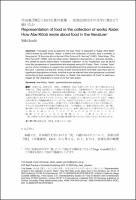Chapter 作品 『壁』における の表象 - 安 公房はその文学に をどう描いたか / Representation of food in the collection of works Kabe: How Abe Kōbō wrote about food in the literature
| dc.contributor.author | Sasaki, Yuki | |
| dc.date.accessioned | 2022-06-01T12:24:19Z | |
| dc.date.available | 2022-06-01T12:24:19Z | |
| dc.date.issued | 2021 | |
| dc.identifier | ONIX_20220601_9788855185066_622 | |
| dc.identifier.issn | 2704-5919 | |
| dc.identifier.uri | https://library.oapen.org/handle/20.500.12657/56437 | |
| dc.description.abstract | This paper aims to examine the way "food" is depicted in “Kabe (The Wall)” (1951) written by Abe Kōbō. “Kabe” is Abe's first collection of works, and it consists of three parts: “S.Karuma-shi no Hanzai (The Crime of S. Karma)” (1951), “Akai Mayu (The Red Cocoon)” (1950), and six other works. Based on discussions in previous studies, I first aimed to clarify where Abe's "consistent intention" in his "Postscript" can be found from the perspective of quantitative text analysis using KH Coder. Then, I chose "food" as one of the indicators to support the worldbuilding and the actions of the characters in the work. I pointed out that the variety of both food and drink is limited, also there are no significant descriptions of taste, and that it can be inferred that what people eat is divided according to their positions in the story. In “Kabe”, the description of "food" is used as a trigger for the characters to move on to the next action. | |
| dc.language | English | |
| dc.relation.ispartofseries | Studi e saggi | |
| dc.subject.other | Abe Kōbō | |
| dc.subject.other | “Kabe” | |
| dc.subject.other | quantitative text analysis | |
| dc.title | Chapter 作品 『壁』における の表象 - 安 公房はその文学に をどう描いたか / Representation of food in the collection of works Kabe: How Abe Kōbō wrote about food in the literature | |
| dc.type | chapter | |
| oapen.identifier.doi | 10.36253/978-88-5518-506-6.05 | |
| oapen.relation.isPublishedBy | bf65d21a-78e5-4ba2-983a-dbfa90962870 | |
| oapen.relation.isbn | 9788855185066 | |
| oapen.series.number | 233 | |
| oapen.pages | 20 | |
| oapen.place.publication | Florence |

